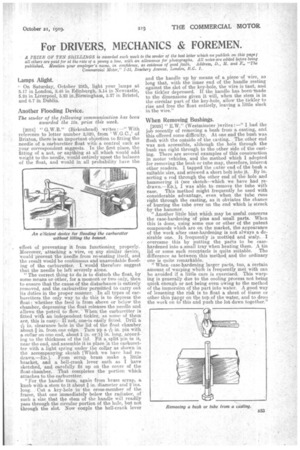For DRIVERS, MECHANICS & FOREMEN.
Page 23

If you've noticed an error in this article please click here to report it so we can fix it.
A PRIZE OF TEN ShILLINGS is aivarded each week to the sender of the best letter which we publish on this page; all others are paid for at the rate of a penny a line, with an allowarice for photographs. All notes are edited before being published. Mention your employer's name, in confidence, as evidence of good faith, Address, .0„ M. and F„ "The Commercial Motor," 7-15, Rosebery Avenue, London, E.G. 2.
Lamps Alight.
On Saturday, October 25th, light your lamps at 5.17 in London, 5.48 in Edinburgh, 5.14 in Newcastle, 6.24 in Liverpool, 5.23 in,Birminghain, 5.27 in Bristol, and 6.7 in Dublin.
Another Flooding Device.
The servier of the following communication has been awarded the 10s. prize this week.
[2024] " G.W .B." (Birkenhead) writes : —" With reference to letter number 2,020, from W.G.C.,'. of Brixton, there is an important objection to fitting the needle of a carburetter float with a Control such as your correspondent suggests. In the first place, the fitting of a nut, or anything at all which would add weight to the needle, would entirely upset the balance of the float, and would in all probability have the effect of preventing it from functioning properly. Moreover, attaching a wire, on any simi,lar device would prevent -the needle from re-seating itself, and. the result would be continuous and unavoidable flooding of the carburetter. I would therefore suggest that the needle be left severely alone.
"The correct thing to do is to disturb the float, by some means or other, for a moment or two only, then to ensure that the cause of the disturbance is entirely removed, and the.earburetter permitted to carry out its duties in the proper manner. In all types of carburetters, the only way to do this is to depress the float: whether the feed is from above or below the chamber, depressing the float releases the needle and. allows the petrol to flow... When the carburetter is fitted with an independent tickler, as some of them are2 this is easy.. If not, on.esis easily fitted. Drill a in, clearance hole in the lid of the float chamber about 1in. from one edge. Turn up a ak in. pin with a collar an one end, about 1 in. or lt in. long, a,ecorcling to the thickness of the lid. Fit a, split pin in it., near the end, and assemble it in place ea the carburete ter with a light spring under the collar as shown in the accompanying sketch [Which we have had redrawn.—En.j. From scrap brass make a little bracket, and a bell-crank lever such as I have sketched, and carefully fit up on the cover of the float-chamber. That completes the portion which attaches to the carburetter.
"For the handle turn, again from brass scrap, a, knob with .a stem to it about in. diameter and 2'ins. long. Out a key-hole in the cross-member of the frame, that one immediately below the radiator, of such a size that the stem of the handle will readily pass through the circular portion of the hole, but not through the slot. Now couple the bell-crank lever and the handle up by means of a piece of wire, so long that, with the inner end of the handle resting against the slot of the key-hole, the wire is taut, and the tickler depressed. If the handle has been-made to the dimensions given it will, when the stem is in the circular part of the key-hole, allow the tickler to rise and free the-float entirely, leaving a little slack
in the wire." •
When Removing Bushings.
[2025] " E.W." (Westminster )writes :—" I had the job recently of removing a bush from a casting, and this offered some difficulty. At one end the bush was flush with the outside of the casting. The other end was not accessible, although the hole through the bush ran right through to the other side of the casting. There are several examples of this construction in motor vehicles, and the method which I adopted for removing the bush or tube may, therefore, interest other readers. I tapped the outer end of the bush a suitable 'size, and screwed a short bolt into it. By inserting a rod through the other end of the hole and hammering it (see sketch—which we have had redrawn.—En.), I was able to remove the tube virith ease. This method might frequently be used with considerable advantage, even when the tube runs right through the casting, as it obviates the chance of burring the tube over on the end which is struck by the hammer. " Another little hint which may be useful concerns the case-hardening of pins and small parts. When this is done, using some one or other of the patent compounds which are on the market, the appearance of the work after ease-hardening is not always a desirable one. It frequently is mottled and scaly. -I overcame this by putting the parts to be casehardened into a .small tray when heating them. A tin lid or some such receptacle is quite suitable. The difference as between this method and the ordinary one is quite remarkable.
"When ease-hardening larger parts, too, a certain amount of waiping which is frequently met with can be avoided if a little care is exercised. This warping is generally due to the cooling process not being quick enough or not being even owing to the method of the immersion of the part into water. A good way of lessening the risk is to float a sheet of tissue or other thin paper on the top of the water, and to drop the work on to* this and push the lot down together.'"
























